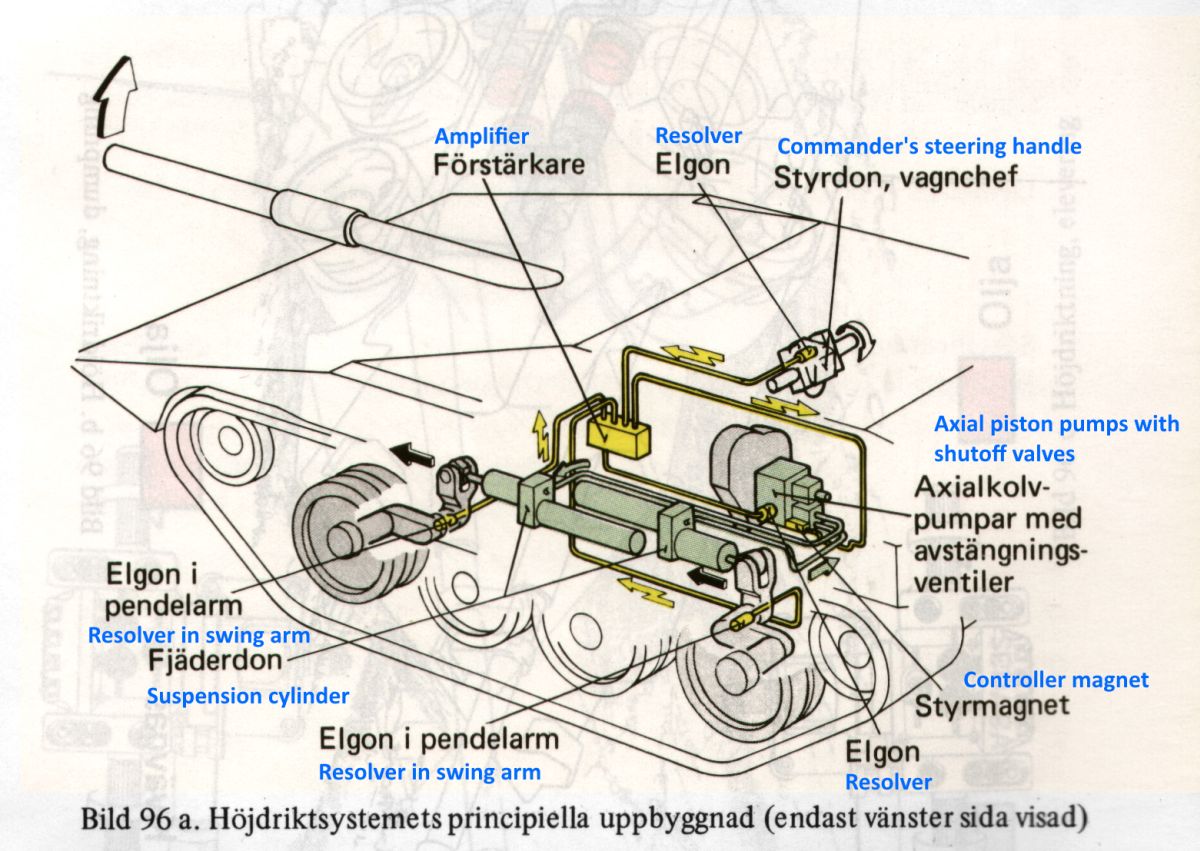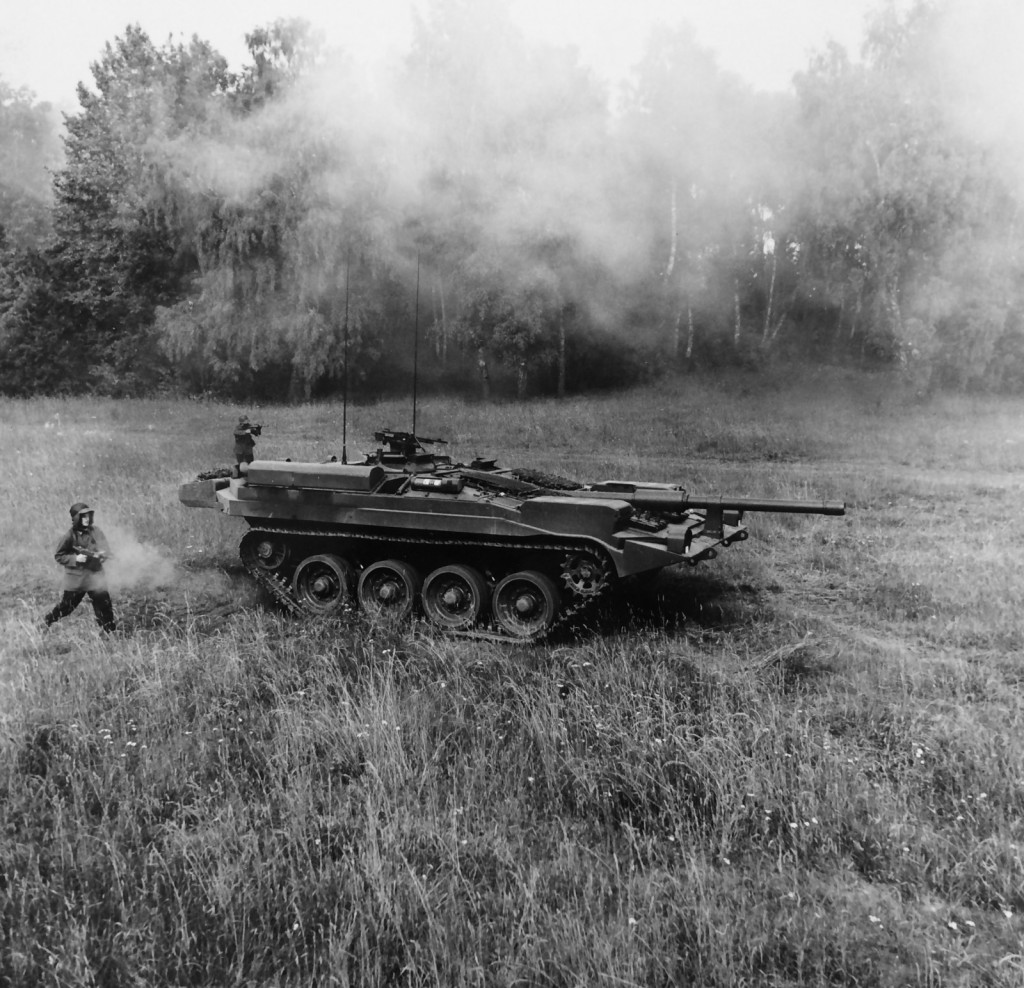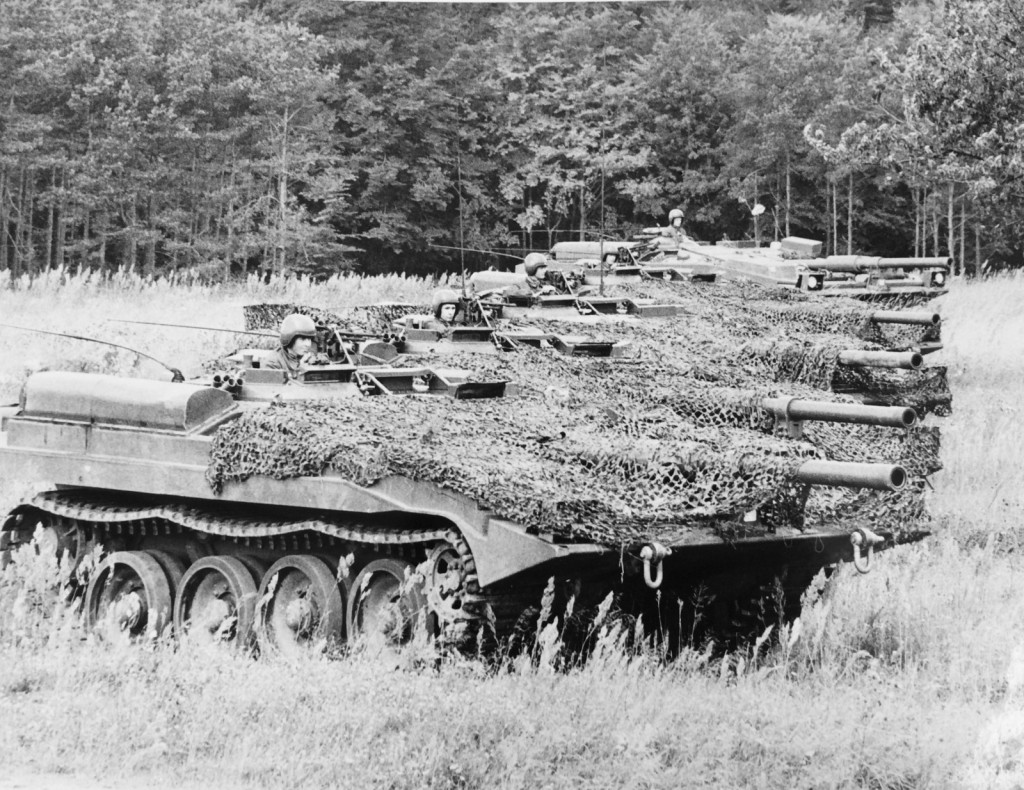Posts Tagged: strv 103
Demonstration of the elevation system on the strv 103
I’m not perfectly sure but I don’t believe these are the full extents of the elevation system – the depression is probably close to the max but I think the elevation could go another couple of degrees. To add to your enjoyment, here are a few pictures from the manual that shows how the system works. “Kvävgas” means “nitrogen”, and “olja” means “oil”.
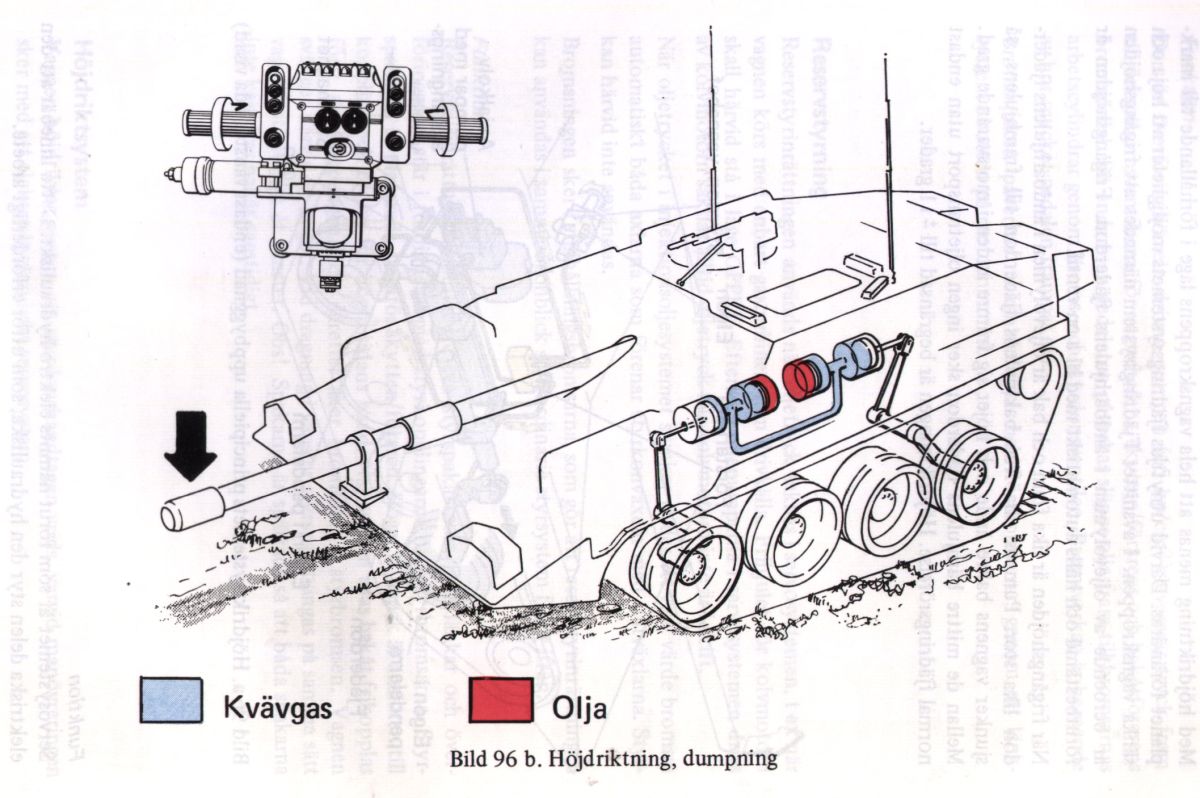
Oil is pumped from the front cylinder into the rear one, the rear swing arm is forced down and the tank depresses.
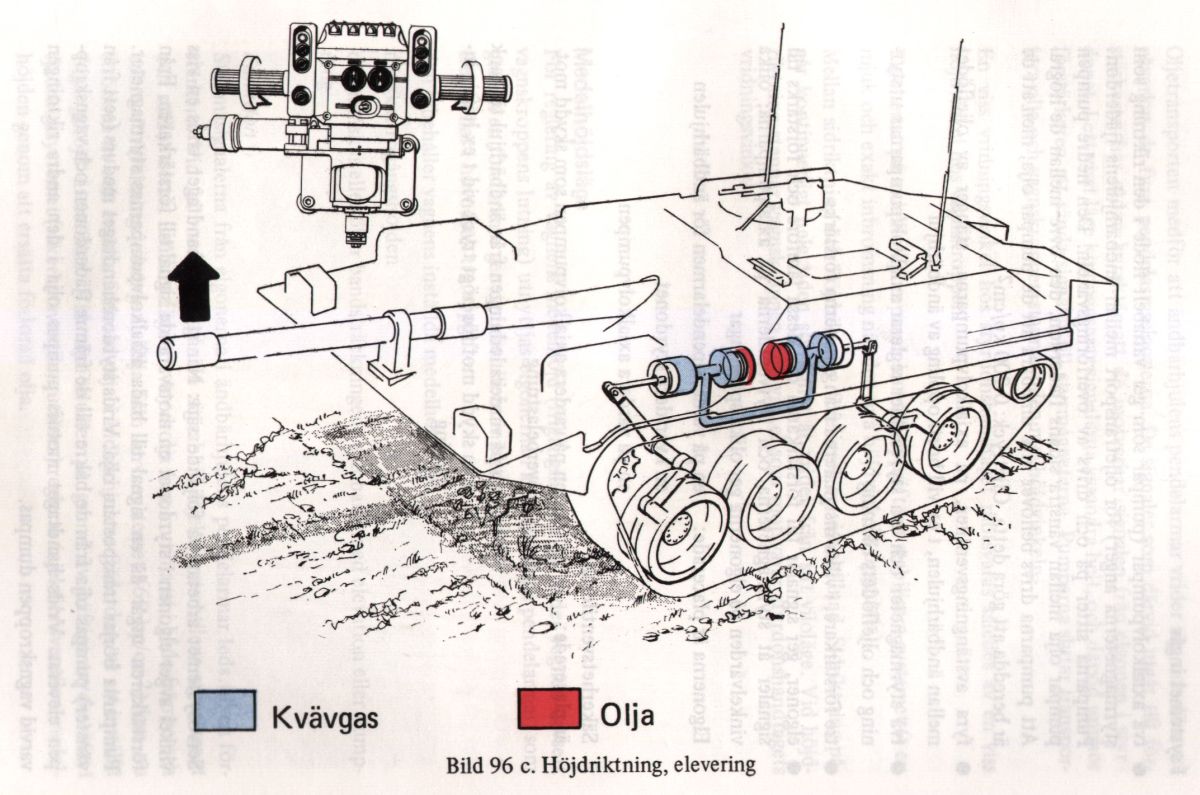
Oil is pumped from the rear cylinder to the front one, the front swing arm is forced down and the tank elevates.
By the way, in case you ever wondered what the heck “elgon” means in Swedish and been unable to find out (the word isn’t in the Swedish Academy Dictionary and is basically ungoogleable), the appropriate English translation is synchro. Naturally, I mistranslated it at first, so where it says “resolver” in the schematic above, it should say “synchro”.
The BAOR in 1973: how bad was it?
I have previously posted the Swedish report from the BAOR trials of the strv 103, but at that time I only took the time to translate a few brief excerpts that I thought were funny. In this post, I’ll go into some more detail and discuss the reasons the Swedish delegation had such scathing things to say about the BAOR. It is somewhat bad form in military history circles to post anything that could be construed as negative towards another country’s armed forces, probably because military types tend to be hopeless nationalists. In this post, I will totally ignore that, which might insult a few people. I must therefore emphasize that these are not my own opinions.
Crew skills
As mentioned in the translated excerpts, during the basic training on the strv 103 in Sweden, the Swedes found British discipline to be rather lax, but more importantly the British gunnery skills were regarded as unacceptably bad in the first trial (after a re-trial, this was upgraded to a mere “poor”). While discipline is subjective, gunnery skills are objectively measurable, and it might be interesting to see how poor the full-time professional soldiers from 2nd RTR crews were compared to Swedish conscript standards.
The Swedish tank gunnery training regulations called for a maximum laying error of 0.2 mils against a stationary target (a number quite close to the mechanical precision of the laying system), and 0.8 and 0.4 mils respectively against a moving target (different numbers for different speeds). When taken as an “exam”, this was tested by firing 20 simulated rounds (using a camera mounted to the gun to judge laying). Each hit within the acceptable margin of error gave 2 points, but you could still get 1 point for a “near miss”. The passing grade and the goal for the conscript training was 39 points, while a “barely acceptable” grade was 30 points. In the first test, results were as follows:
| Crew position | Passed | Barely acceptable | Failed | Best score | Worst score | Mean score | Median score |
|---|---|---|---|---|---|---|---|
| Commander | 1 | 7 | 3 | 40 | 20 | 32.9 | 37 |
| Gunner/driver | 0 | 5 | 7 | 35 | 6 (sic!) | 24.7 | 25.5 |
| Rear driver | 1 | 3 | 7 | 40 | 15 | 26.2 | 23 |
After this less than impressive showing, the crews were made to evaluate their own scores (probably to shame them into taking the test seriously next time) and then the test was re-done, this time excluding the rear drivers since they normally wouldn’t be firing anyway. Results were much improved (except in the case of one gunner/driver who got barely acceptable in the first test but failed in the second), but still not up to Swedish conscript standard:
| Crew position | Passed | Barely acceptable | Failed | Best score | Worst score | Mean score | Median score |
|---|---|---|---|---|---|---|---|
| Commander | 7 | 5 | 0 | 40 | 31 | 36.75 | 39 |
| Gunner/driver | 3 | 7 | 2 | 40 | 25 | 35.7 | 37 |
There was one commander who was not tested the first time around, hence the mismatch in numbers between the two rounds.
Results were even worse when it came to how long it took between a target showing up and the crew opening fire. Swedish training regulations called for no more than 17 seconds; the best British score was 18.5 seconds and the worst 36 seconds (mean: 28 seconds). This was not solely because of low crew standards, but rather because the British doctrine forbade the gunner/driver from acting on his own initiative: orders from the commander were always required for everything, and this slowed things down considerably.
The only trial in which the British crews were mostly up to par was target spotting (tested as a crew, not individually). The training regulations called for spotting 74% of targets on a standardized training course; the British crews achieved a mean of 72% (worst: 55%, best: 95%).
Considering the results above, it is not difficult to see why the Swedish observers wrote that “a large portion of the British gunners simply weren’t suited to their job”. Some of them wore glasses, which would have been an impossibility in the Swedish army: conscripts had to have perfect eyesight to even get considered for assignment as tank crews.
During the actual trials, the British crews complained about how much time they needed to spend on daily maintenance tasks. In a particularly acerbic comment, the observers concluded that this was mainly since on the Chieftain, crews usually took shortcuts on the maintenance if they bothered to do it at all, but on the strv 103 the contract with the Swedish army forced them to do it by the numbers. The observers also noted that the 1968 test report had concluded that the strv 103 needed less time for crew-serviced maintenance tasks than the Chieftain did.
In the public perception, conscripts tend to be viewed as poorly trained and motivated. However, as demonstrated here, the recruitment method used does not necessarily determine soldier quality. It is possible to train full time soldiers more and longer than conscripts, but this is not always done. Poor motivation and low morale can be found in both conscript and professional armies (Swedish conscript motivation varied over the years – for example, when the public perceived less of a threat to the country, motivation tended to be lower and morale was worse). Conscription also provides the opportunity to pick and choose the person best suited to the job out of all able bodied men (and women, these days) from each age class. It should be kept in mind though that this report was written at what was probably the very peak of the Swedish Cold War army: around the mid-1970’s, budgets started shrinking, refresher exercises were reduced and basic training periods were shortened. At the same time, these years were probably some of the worst for the British army.
Doctrine issues
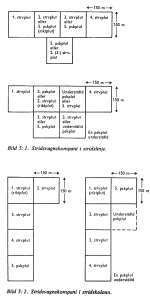
Swedish tank company on the offense, in line or in column, with and without an extra mechanized infantry platoon attached. (strvplut = tank platoon, pskplut = mechanized infantry platoon)
By far the biggest beef the Swedish delegation had with British tactics was the very wide spread of tank formations. The observers complain in several places in the report that the British platoons could spread as far as 5-600 meters on the offense, and up to 800 meters on the offense. In part, this friction was caused by doctrinal differences. Swedish tank platoons were, as per the field manuals, assigned front sections no more than 150-200 meters wide – a British platoon could cover the same width as an entire Swedish tank company did when attacking in line formation (see graphic). The Swedish school of tanking was heavily German-inspired, with schwerpunkt and auftragstaktik and all, so concentrating forces was essential to the tank formation commanders. This is perhaps best illustrated with a few choice quotes from the 1966 field manual for Swedish armored battalions (the bold parts are in the original).
1:17 Our armored units must be prepared to meet enemy units that are superior to ours in various ways, for example in the number of tanks. Our units shall compensate for this superiority by mastering suitable tactics and ways to do battle.
1:19 The firepower, mobility, ability to pass difficult terrain and armor protection of the armored units shall be used for quick and surprising attacks with concentrated forces.
1:20 (…) When encountering the enemy unexpectedly, the armored units shall seek the initiative and attack as soon as possible to reach success. (…)
1:24 Fire and maneuver are the two main components of battle. They must be coordinated in both time and space.
Fire – especially tank gun, anti-tank gun and artillery fire – is the most important component of the battle for the armored units. The fire is complemented by the use of smoke.
1:27 The opportunity to create local superiority must be exploited whenever possible. Local superiority is mainly created by concentrating the fire from tank and anti-tank guns and artillery, as well as by the use of smoke.
When fighting enemy armored units, it is not just merely the number of weapons that determine local superiority. The unit that is first to open fire and shows the smallest target is usually the one that succeeds. Quick and well-aimed fire is of crucial importance.Local superiority shall be used opportunistically both for anti-tank work and to neutralize the enemy anti-tank units.
1:28 Concentration of force means that sufficient resources, especially fire, are focused in time and space.
Concentration shall be brought about in the direction or in the area where a decisive result is sought or expected. In other directions, the weakest possible resources are assigned.
The concentration of force is usually achieved though coordination of several different units.
In many cases, assembling several companies in a relatively small area is required for the concentration to be effective. Before the battle is started, however, they shall be gathered for as short a time as possible, so the enemy does not have time to deploy nuclear weapons against them.
When assembling an armored battalion, two or more companies should not be assembled for more than an hour.
In a crisis, focusing fire – especially tank gun, anti-tank gun and artillery fire – usually the quickest way to turn the situation around to our favor.
2:2 The fighting actions of armored units usually develop quickly and violently, with frequent and sudden changes in the situation. Frictions are a constant. A commander must be able to quickly find his bearings in every kind of situation. Even with limited intelligence and in the most difficult of positions, he must be prepared to make crucial decisions and carry them through.
For a commander, indecisiveness and failure to act is a greater failing than choosing the wrong means of action.
2:11 In war, only simple things are possible. Straightforward plans, well executed, are the safest path to success.
These passages (particularly 1:28) should be enough to give at least an overview of the Swedish doctrine: focusing fire (both tank gun and artillery fire) from good positions and concentrating forces in small areas were seen as crucial components of success. Contrary to what you might think, Swedish armor officers were doctrinally very aggressive and taught to attack in almost every situation to gain and retain initiative. Concentration of force and especially of fire was seen as absolutely essential on all levels, and the observers complain a lot about how the Brits don’t do this, or don’t do it enough (the wide deployments usually prevent focusing fire within the platoon).
These complains are, of course, a lot more subjective than gunnery trials, but the observers note a number of tactical situations from the exercises that seem to confirm their view that the British habit of deploying tanks 3-400 meters from each other isn’t appropriate, which brings us to the next section.
Tactics
During the trials (both the fixed situations intended to compare the strv 103 and the Chieftain and the bigger field exercise), the observers noted many behaviors that seemed odd or downright bizarre. As mentioned, one of these was the great width used within British platoons. In several of the fixed situation trials (especially on the defense) this led one of the tanks on either flank getting isolated, overrun and destroyed. Focusing fire was rarely possible, which led to most situations ending up as duels. In one of the trials, the observers note the entire thing as “a great example of how this type of battle should not be fought”.
Another common complaint is poor coordination in general but especially poor coordination with infantry. In several cases the British tanks advance on their own into and through forests. In at least one case, tanks advancing along a narrow forest road together with infantry on foot does not use the infantry to scout the sides of the road or ahead, leading to the tanks driving out into an intersection where there’s an enemy tank in ambush. The infantry is not called upon to locate the enemy tank even after the first tank in the column gets destroyed. This was seen as bizarre by the Swedish observers, who in many similar situations in forests etc called for dismounting the rear driver and using him for observation on foot.
The infantry itself was complimented on showing “very good fighting spirit”, “likely because the company had just returned from Northern Ireland”, but its way of fighting was considered odd at best. In one trial where six tanks (deployed in firing positions) and a dismounted mechanized infantry platoon defend a few buildings against six tanks and three APC’s, the following observation is a good illustration of what the observers thought:
1. All 103’s in firing position at the start of the exercise.
2. APC’s advance. All the commanders in “peace driving mode” with their heads above the edge of the hatches. The APC’s drive up in a column, stops 50 meters in front of [a defending tank]. Infantry dismounts. Pure madness!
3. When the infantry attacks from the right, [the defending tank] turns the entire vehicle and fires with the fixed machine guns, without turning the cupola and opening fire with the commander’s MG first.
(…)
An older German local gentleman (retired officer?) came up and asked if you really could do things this way.
Artillery and smoke were used sparingly if at all during the field exercise, despite artillery officers and forward observers being attached. The observers complained much about how there was no concentration of fire in that respect either, nor any coordination of fire and maneuver to speak of. There were also several complaints about passivity in general – tanks sit still in prepared positions despite being attacked without seeing the attacker, that sort of thing. In many cases the observers also complained about what was seen as blatantly incorrect behavior, like advancing a tank column into an ambush without recon.
Readiness issues
I’ll just post a translated excerpt from the report here.
(1) Armored vehicle (Chieftain, FV 432) reliability seems quite low. When there are no exercises ongoing, the vehicles are test driven once a week. When units or parts of units leave for service in Cyprus or Ireland or for exercises in Canada, a minor detachment is always left behind to service and check on the vehicles.
When the armored vehicles are parked in their garages, they are not filled with ammunition or the crew’s combat equipment, as is done at f.ex. American units.
(2) Since units and parts of units that are assigned to the BAOR are in service on Cyprus, in Ireland or are on exercises in f.ex. Canada, the forces present in Germany likely have a relatively low readiness as a fighting unit. Additionally, personnel is more or less constantly transferred between units, so the units are likely rather poorly trained as a team.
(3) Each year, units typically do about two weeks of exercises in Soltau, two weeks of gunnery training in Bergen Hone and one bigger field exercise/maneuver in the Kassel area. The rest of the year the personnel seems to spend their time mostly idle in their barracks. Every second or every third year, the units are sent to Canada where live fire exercises and combat exercises are done.
Alert response exercises are done about once a month. No such exercise was done during the current period.
(4) Considering the state of the equipment, the constant detaching of units, the circulation of personnel and what has been noted in other places in this report regarding the skills of commanders and crews, as well as what officials have told us about alcohol and drug problems, the British Army of the Rhine should not be seen as being of any higher class.
(My underlining in the last paragraph.)
Stridsvagn 103 trials in the US, 1975-1976
Two strv 103’s were sent to the US for trials in 1975-1976. Seven US crews were trained and the tanks were subjected to a variety of tests, in which they were compared to a variety of odd vehicles, ranging from the mundane M60A1 AOS (add-on stabilizer) to a T-62, an RVT-2 (a West German experimental vehicle with 1800(!) horsepower – see the comments section for more information) and an XM808 TB (8-wheeled Lockheed experimental vehicle). The report from these trials is over a thousand pages long, but I have only managed to find a small part. I’m working with the national archives to get the entire thing declassified, but it’s been met with some bureaucratic issues due to the US classification levels.
Nevertheless, I’ve obtained a few summary pages that in themselves contain a number of interesting tidbits. For example, did you know that when comparing gun laying times against a stationary target from the short halt, the strv 103B was faster to fire (although somewhat less accurate) than the M60A1 AOS? In the stationary vs stationary case on the other hand, the strv 103 layed slower but hit better. When averaging about 400 fired rounds of various types in a variety of situations against a variety of targets at different ranges between 500 and 2000 meters, the strv 103 hit an average of 77% of shots and took an average of 13.1 seconds to open fire, while the M60A1 AOS hit an average of 72% and took an average of 12.7 seconds to open fire (it should be noted here that the M60 was using its coincidence rangefinder, while the strv 103 had no rangefinder at all). In a mixed driving trial, the strv 103 was slightly faster than the M60 but accelerates slower.
You can read the fragments in PDF form here – and for once, they’re mostly in English.
Stridsvagn 103 Was Not A Tank Destroyer
In internet arguments and popular culture, it is frequently claimed that the stridsvagn 103 (strv 103, “S-tank”) was a defensive tank, or basically a modern tank destroyer. It was, claims the common wisdom (perpetrated and repeated in media such as History Channel), meant to dig down in a forest, take a few shots at attacking Soviet tanks and then retreat, using its rear driver to its advantage. In the recently revealed Swedish tree for World of Tanks, it is indeed classified as a tank destroyer – mainly for game mechanics reasons, though, not because of a misunderstanding of its role. Even in the Swedish army, some officers (mainly ones who had no experience on the tank) thought it was worthless for traditional tank work – that is, offensive tasks. In this essay, I will show that this is simply not true: the Swedish army set out to figure out how to build a good tank, came up with the S-tank idea, developed and built that idea as a tank, which it then proceeded to use operationally as a tank.
Stridsvagn 103 0-series, Ravlunda, 1966
I’m sitting on a ton of photos from the national archives that aren’t of any use to anyone. That needs to change, so I’ll start posting one a day or so here. Enjoy!
Report from British strv 103 trials at BAOR, 1973
In the summer of 1973, the British Army on the Rhine (BAOR) evaluated the strv 103B in the field. The crews were ordinary British tank crews from the 2nd Royal Tank Regiment, who were sent to Sweden to train on the 103 for four weeks. Ten tanks were then sent to Germany for several months worth of field trials. This report, authored by the Swedish observers from the Swedish Armored Forces School covers the results – such as they were – of these trials.
In general, the observers consider the results of the evaluation to be highly dubious at best. The trials were conducted in such a haphazard and unscientific manner that the results were considered mostly useless. The observers also devote a lot of space to scathing criticism of the BAOR. I’ve translated some of the more interesting passages below – it’s highly entertaining reader.
By request from a reader, I have provided the report as a PDF in addition to the ordinary image gallery.
The observers on the quality of British tank gunners
At the end of the gunnery training, there were two tests with a gun camera, one against a fixed target and one against a moving one, as per usual Swedish standard. The results were bad. The first time these results may possibly be explained by the gunners not taking the trial seriously, but even after they had evaluated their own results and re-did the test the results were very bad. It is possible that more training could have improved the results somewhat, but the more likely explanation is that a large portion of the British gunners simply weren’t suited to their job as gunners. In some cases, problems with bad eyesight were apparent. It should be noted that British tank personnel is not tested in the same way as Swedish personnel before being assigned as tank gunners.
(pg 15)
Both the methods the tank crews used for engaging targets and their aiming skills were unacceptable and clearly worse than that of the average Swedish crew.
(pg 15)
Swedish tank crews were conscripted. Tank crews were considered a particularly demanding position and the requirements for getting assigned to one were very high.
On crew resource management etc
The number of targets detected was on par with the performance of Swedish crews. However, the time from detection to opening fire was in most cases far longer than can reasonably be expected. In part, this is due to lack of training on the 103, but more importantly it’s also due to the way the British crews work together. The tank commander always have to give orders about everything and the gunner is forbidden from opening fire on his own initiative when he spots a target, unlike in Swedish regulations for tank crews. Just like in the 1968 trials, it has been impossible to convince the Brits to try the Swedish method, which is also employed by the Germans for example. The reason cited by the Brits is that tanks carry so few rounds that the commander cannot risk the gunner opening fire on a non-essential target and that the gunners in general aren’t all that good at neither judging the importance of a target nor at correcting their own fire.
(pg 14)
Nor were the Brits willing to accept the principle that whoever sees a target first fires on it. If the tank commander spots a target, the gunner should still open fire on it. According to Swedish tests, if the commander has to hand the target over to the gunner, the time to open fire is on average two seconds longer than if the gunner opens fire by himself. If questions regarding the target’s exact position are raised, this time increases further, up to 10 seconds or more in many cases. Our proposal to try the Swedish method in parallel with the British was rejected without any reason given.
(pg 14, pg 45)
These limitations in engagement methods severely limited the advantages of the strv 103’s duplicated controls.
On discipline and exercise of command
Exercise of command was relatively tame and commanders rarely supervised anything. The subordinates were left with a lot of freedom to complete rather ill-defined tasks on their own. When it came to looking after their equipment, the personnel was rather sloppy and nonchalant.
(pg 13)
On tactics
(in a discussion on fighting delaying actions) The target marker equipment made this exercise an excellent and very illustrative example of how not to fight this type of action (in both Chieftain and the strv 103).
(pg 85)
We would like to call some attention to the British regulations on deployment width for tank platoons. When deploying for defense, a platoon can be deployed over a width as great as 800 meters! Even during attacks, the width frequently reached 5-600 m. The combat simulation equipment often proved that these regulations are clearly inappropriate. The platoon rarely had any means of concentrating its fire and thus the enemy picked tanks off one by one. The British reasoning is “the enemy advances on a broad front and has many tanks, we are few but must cover the entire width”. The German liaison was horrified by this philosophy and the British conduct!
(pg 45-46)
On performance in major field exercises
The last part of the trials was conducted as a major field exercise. The BLUFOR had Chieftains only, the OPFOR mixed Chieftains and strv 103’s. The OPFOR “won”, but the Swedish observers dismiss the results as “highly questionable”.
The BLUFOR tank units appear very unprofessional. They use unsuitable formations, roads and combat positions. In general, they appear to think they are invulnerable. Tank commanders and loaders stand very far up in their hatches. Drivers have hatches open and drive with their head above the edge.
There is no coordination of attacks between tanks, infantry and artillery. Tanks attack alone into forests. Infantry attacks alone across open fields straight at defending tanks. When attacking, units are not concentrated, neither in space nor in time. Attacks are always conducted in a “trickling” fashion.
Radio traffic is very intensive but there are rarely orders given.
At the OPFOR, unit commanders are often deployed very far behind their units, battle group commanders about 5 km behind and combat team commanders 500-1000 meters behind.
CYCLOPS (the strv 103 squadron) combat positioning during the delaying action was usually pretty good.
All tanks, both Chieftain and strv 103’s, are driven very carelessly. No attention is paid to neither civilian traffic nor property damage. Reports on engine failures have a hard time reaching the maintenance units. Map reading capabilities are overall very bad.
When the exercises ends, 9 out of 10 strv 103’s are fully combat ready.
The experiences from these exercises appear to be highly questionable.
(pg 141-142)
British tank crews always carry a lot of baggage, both combat and non-combat equipment (cooking equipment, food, tents etc), on and/or in their tanks. Unlike our crews, they are completely independent of separate cooking units and baggage trains. This meant that the space available in the strv 103 was far too small for their equipment.
(…)
Very little attention is paid to the fact that the unit is exercising on private property. Driving on public roads is very careless and the exercise area is not marked or delimited. Damage to planted fields is frequent despite good opportunities to choose routes over fields where the harvest has already been taken in. Apparently the property damage costs for a similar exercise in the same area last year were on the order of 10 million SEK (about 62 million SEK today, ~6 million EUR). These damages are paid for by the German authorities. During this year’s exercises, five people died in accidents; during the same exercise last year, thirteen people died.
Strike aircraft are available on request during the exercises. Helicopters are used for both recon and command duties. The routines for coordinating with airplanes and helicopters seem to be well developed. The British command APC is well suited to its purpose and the space available is better than in our equivalent vehicle. Wired communications are not used between brigade staffs and battle groups. The system with call signs painted on the rear of the tanks appears to work well.
(…)
Deployment width and depth is considerable in the smaller units. Tank platoons are often deployed over a width/depth of 600-800 meters. (…) Tank platoons are frequently deployed independently behind each other. Support is organized within the platoon and not between platoons. The rear platoon is usually 500-1000 meters behind the front one. Hence, the result is that the enemy knocks them out one by one, platoon after platoon. Both platoon commanders and tank commanders act very independently and choose both their own routes and positions and their own timings for advancing or repositioning. The whole thing frequently resembles a guerrilla war or every man for himself.
The infantry is used way too late to take terrain from which the enemy can fight the tanks up close with weapons such as recoilless rifles. The tanks attack first. When they start taking fire, the mechanized infantry is deployed. There is no planning for attacks in depth. On the first day, it took seven hours to advance seven kilometers with the BLUFOR’s combat team (17 tanks and a mechanized infantry platoon) against an OPFOR with 9 tanks and one mechanized infantry platoon, deployed in three lines.
If a platoon or squadron commander’s tank gets engine problems, the commanders do not move to another tank. Tanks are frequently deployed in very unsuitable positions where they are easily knocked out. The observation and recon duties are conducted badly. The soldiers seem very passive. Chieftains are often positioned behind a ridge with the gun and the chassis side against the enemy. The strv 103 crews rarely clean their optics.
When fighting a delaying action, the tanks in a platoon retreat by turns along the whole depth of the deployment. Withdrawal is frequently started far too late, and the tanks are thus knocked out one by one. Despite the terrain allowing opening fire at long distances (2-3 km), fire is often opened far too late (500 m). There is never a rear platoon deployed to cover the front platoon’s withdrawal.
In light of the heavy criticism above, it has been very hard to judge how well the strv 103 has proven itself. The results have mostly been influenced by troop performance and not by the tank’s performance. As far as it has been possible for us to observe, though, we cannot say that the strv 103’s have suffered more losses than the Chieftains.
Strv 103 availability has been good. Most of the time all tanks have been in working condition during the day. On the OPFOR side, the Chieftain availability has dropped steadily. Near the end of the exercise the availability was down to 50%, and thus a Chieftain platoon was transferred from BLUFOR to OPFOR.
(pg 127-128)
On British vehicles
The Chieftain tank:
The reliability seems surprisingly low. During the exercises, the number of tanks that had to drop out due to mechanical trouble was relatively high. Mostly, it’s the engine that is the problem. When a Chieftain stops, after a little while there’s always an oil slick on the ground or garage floor under it. The gun stabilization also fails frequently. The accuracy of the contra-rotating feature in the commander’s observation cupola is very low. It is almost never used by the Brits. The tank’s speed over terrain does not seem to be superior to that of the S-tank. The commander’s observation equipment is very good.The Scorpion tank:
The Swedish personnel got an excellent briefing on the tank and was also allowed to drive it. It is very fast and easy to drive. The observation equipment is absolutely excellent. (…)The FV 432 APC:
Appears to have a large number of different reliability problems, mainly concerning the steering gears. The vehicles are so far gone that they are considered a danger to traffic. According to maintenance personnel, a lot of the problems are caused by the soldiers not doing sufficient daily maintenance.(pg 146)
Read the entire report in PDF form, or hit “Continue reading” to browse the photographed document images on this web page.
Archive reference: SE/KrA/0092/A/A2/001:H/F1-1974/35

